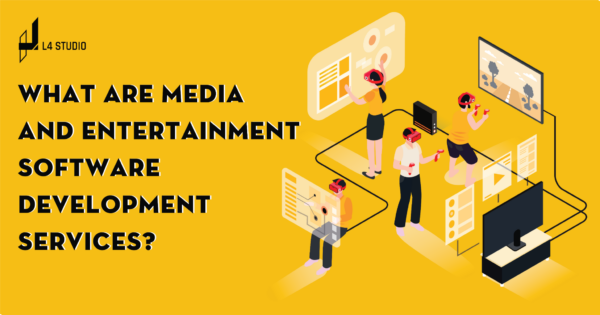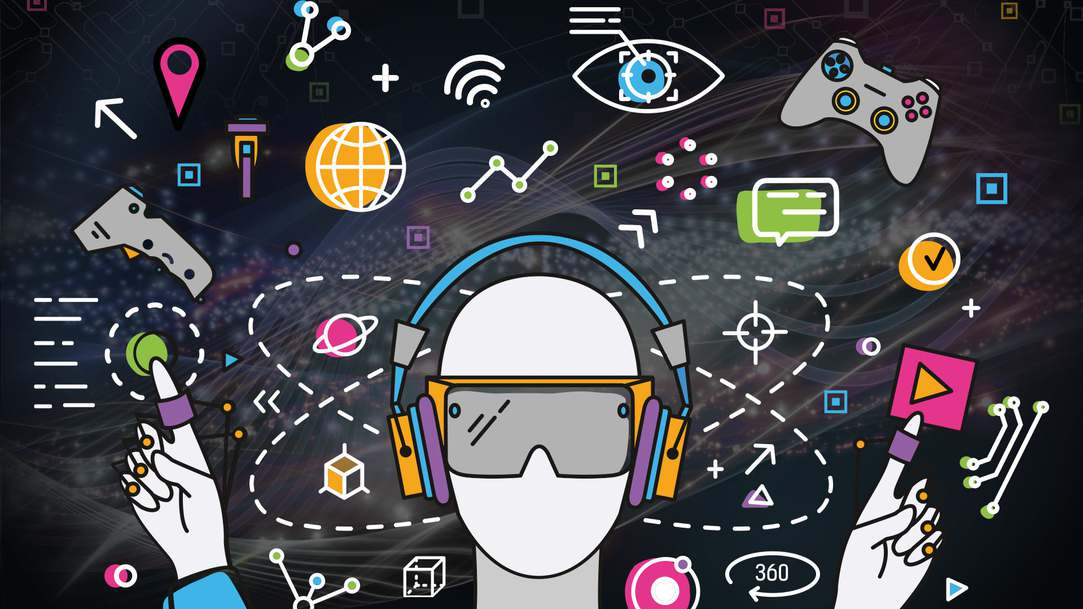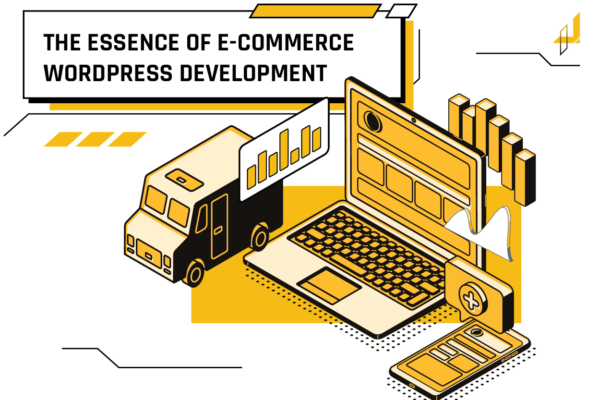
What are IT outsourcing company media and entertainment software development services?
The advancement and growth of technology have supported people all over the world in a variety of ways. The entertainment industry is one that has seen a paradigm shift as a result of technology. But not every entertainment company can have its own developer team; that’s why we need help from an IT outsourcing company.
1. Is IT outsourcing company the entertainment industry’s future?
It is unsurprising that technological advancement is transforming the entertainment industry in every way. In the midst of a global pandemic in which people are unable to go outside, hang out with friends, go clubbing, or to the theater to watch new box office releases, the demand for online video streaming services has skyrocketed.

Figure 1. Entertainment in the future will revolve around technology
The entertainment industry is looking for new ways to adapt the digital landscape to make it a better part of the decade. Businesses are making every effort to provide new user experiences and connect with their customers in the best ways possible. With the increasing demand for internet services and meaningful and high-quality video content, TV subscription plans have taken a back seat.
Moreover, countries such as Italy and the United States have seen a significant increase in digital content consumption from various sources such as TV streaming, gaming, and mobile apps. The rapid adoption of mobile apps for accessing social media and other entertainment platforms (thanks to the IT outsourcing company) is expected to fuel the rise of online streaming services.
2. Which technologies are preferred to use in media and entertainment services?
2.1 Augmented Reality and Virtual Reality
We spend a lot of time these days staring at screens. Computers, cellphones, and televisions have all become an important part of our lives; they are how we obtain much of our news, use social media, watch movies, and do a variety of other things. Virtual reality (VR) and augmented reality (AR) are two technologies that are altering how we interact with displays, resulting in new and fascinating interactive experiences.
Augmented Reality and Virtual Reality have dominated the entertainment industry. The most promising technological advancement improved the connection between viewers and content creators. Pokemon Go has demonstrated the potential of AR and VR. AR/VR is being considered by business behemoths such as Google and Facebook to improve accessibility, mobility, and pricing. Whether it’s narrative content or live streaming, virtual reality and augmented reality app development improves the user experience like never before.
2.2 Wearable Technology
Wearables are objects that contain electronic technology or equipment that can be comfortably worn on the body. These wearable gadgets are used to collect data in real time. They contain motion sensors that record your daily activities and sync them with mobile devices or laptop computers. Wearable electronics are the next significant advance in the realm of technology after smartphones.
Every single IT outsourcing company around the globe agrees that wearable technology is the most potent tool for making the entertainment industry more immersive. It introduces new methods for users to access content easily. Users of wearable devices can watch augmented reality videos, listen to music, and play virtual reality games.

Figure 2. Wearable technologies can boost user experience while entertaining
The introduction of wearable app development simplifies content delivery. It ensures that the content is delivered in a trimmed-down format without leaving out important details.
Wearable technology is intended to have an impact on the domains of health and medical, fitness, aging, handicap, education, transportation, enterprise, finance, gaming, music, and so on. The idea is to seamlessly integrate into people’s daily lives and become a functioning part of them.
Wearable computing gadgets are particularly valuable for organizations due to their hands-free nature. It becomes easier to track the emergency and rescue teams, making the workplace more efficient and safe. Hands-free access to critical data and information via smart glasses and smart watches allows researchers, engineers, and technicians to work more efficiently.
2.3 Video technology
Communication quality and efficacy have increased as a result of video technology. Face-to-face connection is enabled with video conversations and conferences, which improves communication by allowing participants to interpret facial expressions and body language. This is especially true in business meetings and interviews, when nonverbal indications may be as significant as verbal communication.
In addition to communication, video technology has also transformed the entertainment industry. Streaming services such as Netflix, Amazon Prime, and Hulu allow viewers to watch their favorite movies and TV shows on demand, anytime and anywhere. Video games have also evolved significantly, with advanced graphics, immersive gameplay, and online multiplayer capabilities that allow players to connect with others around the world. This has given audiences more control over how and when they consume media, and has allowed for greater diversity in content.
Without a doubt, video streaming is the most significant addition to the entertainment industry. The master approach for correct content delivery is a visual representation, but it is difficult to create multiple video pieces for different audiences. To make the process easier, video development technology such as API solutions and automated video creation solutions are used.
2.4 Voice recognition technologies
The rush for speech usage in mobile applications, websites, cell phones, and smart speakers demonstrates customers’ strong desire to interact with technology through dialogue. In recent years, there have been countless little but major indicators throughout the media and entertainment industries that this business is ready to accept, understand, and, most importantly, exploit speech technology.
Ignoring voice search technologies may result in the entertainment industry’s most significant loss. Smartphone users are increasingly relying on voice-driven solutions and smart speakers for quick results. Voice recognition technology, which combines Artificial Intelligence and Machine Learning, is constantly working to optimize content and provide a more transparent and personalized user experience. Google assistants such as Siri, Amazon’s Alexa, and Microsoft’s Cortana are excellent examples of successful voice recognition solutions.
The public’s acceptance of voice has expanded faster than smartphone ownership. Voice commerce is expected to reach $80 billion by 2023, with its applications expanding fast as it becomes the preferred entry point for viewing video content.
2.5 Artificial Intelligence
Artificial intelligence is a new trend in the media sector that is affecting TV, VFX, radio, and other areas. Entertainment companies have a large unstructured digital data collection that can be categorized and analyzed using AI tools. In predicting user involvement with information, artificial intelligence, machine learning, and natural language processing are all equally successful.
M&E firms have a large reservoir of unstructured user digital data. Mining and filling this digital data now has a human-like component thanks to artificial intelligence.
AI is good at rapidly assessing and recovering emotional changes, which is information required to better understand customer behavior and digital media consumption trends. Because of this reliable data, it is feasible to make specific advice on how to enhance content.
Many streaming applications use AI technology and advanced machine learning algorithms to provide videos, audio podcasts, and high-quality streaming music that their audience would most likely bookmark.
AI technological advancements aid in the classification of digital data based on shared characteristics. A corporation may forecast user involvement in this manner, providing for improved revenue potential. Spotify, for example, employs several AI methods when making suggestions for new music that listeners eventually fall in love with. Because of the rapid growth of Big Data and the complexity of new algorithms, these recommendations will become more detailed in the near future.
2.6 Last but not least: Cloud security
The creation and delivery of media using cloud infrastructure is a paradigm shift, and one of the most significant technological changes the media and entertainment (M&E) sector has seen in the last 2 decades. The ease of delivering content to all consumer screens combined with the increased rate of innovation are the main reasons many M&E companies are increasingly adopting cloud technologies. Increasingly demanding global consumers are another driver.
In addition to intake, storage, transcoding, animation tools, and media asset management, M&E-specific cloud solutions offer metadata, closed captioning, and subtitling services. The cloud offers distant content storage in a networked environment, meeting storage demands such as high throughput and capacity while also enhancing content availability and reach. The cloud facilitates reusing material on a range of devices, hence increasing content distribution across all channels. Another crucial component that is benefiting from cloud usage is advertising.

Figure 3. Cloud security has become more important as entertainment technologies evolve
Cyberattacks have not spared the entertainment industry. Remembering the unfortunate Sony Pictures Entertainment breach in 2014, in which 40 gigabytes of highly confidential and sensitive business data, including personal emails, were hacked and posted online.
Cloud security management is constantly fighting cyberattacks in order to keep the entertainment industry safe from such illegal attempts. It prevents piracy by authenticating and removing illegal online content streaming. The cloud management system keeps track of the production networks, customer data, access control, and IT policies. As more entertainment organizations migrate to the public cloud, factors such as cloud workload and data encryption will take center stage.
Summary
The last few years have redefined the true meaning of entertainment. Now with affected of the COVID-19 pandemic, people are forced to stay at home, and demand for online entertainment is skyrocketing. Not every entertainment company can adapt to this change, but you can seek help from an IT outsourcing company to make it happen.
Sources: Internet
——————————-
L4 STUDIO – LEADING SOFTWARE DEVELOPMENT COMPANY IN VIETNAM
Website: https://l4studio.net/
Email: hi@l4studio.net
Phone: (+84) 28 6675 6685
Our Mobile App Development Services: https://l4studio.net/mobile-app-development/
For more interesting blogs: https://l4studio.net/it-knowledge/
Follow us at: https://www.facebook.com/L4Studiovn/
Read more: INTRODUCING RETAIL SOFTWARE DEVELOPMENT IN HO CHI MINH CITY








